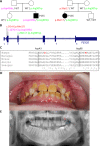Next-generation sequencing reveals the mutational landscape of clinically diagnosed Usher syndrome: copy number variations, phenocopies, a predominant target for translational read-through, and PEX26 mutated in Heimler syndrome
- PMID: 28944237
- PMCID: PMC5606877
- DOI: 10.1002/mgg3.312
Next-generation sequencing reveals the mutational landscape of clinically diagnosed Usher syndrome: copy number variations, phenocopies, a predominant target for translational read-through, and PEX26 mutated in Heimler syndrome
Abstract
Background: Combined retinal degeneration and sensorineural hearing impairment is mostly due to autosomal recessive Usher syndrome (USH1: congenital deafness, early retinitis pigmentosa (RP); USH2: progressive hearing impairment, RP).
Methods: Sanger sequencing and NGS of 112 genes (Usher syndrome, nonsyndromic deafness, overlapping conditions), MLPA, and array-CGH were conducted in 138 patients clinically diagnosed with Usher syndrome.
Results: A molecular diagnosis was achieved in 97% of both USH1 and USH2 patients, with biallelic mutations in 97% (USH1) and 90% (USH2), respectively. Quantitative readout reliably detected CNVs (confirmed by MLPA or array-CGH), qualifying targeted NGS as one tool for detecting point mutations and CNVs. CNVs accounted for 10% of identified USH2A alleles, often in trans to seemingly monoallelic point mutations. We demonstrate PTC124-induced read-through of the common p.Trp3955* nonsense mutation (13% of detected USH2A alleles), a potential therapy target. Usher gene mutations were found in most patients with atypical Usher syndrome, but the diagnosis was adjusted in case of double homozygosity for mutations in OTOA and NR2E3, genes implicated in isolated deafness and RP. Two patients with additional enamel dysplasia had biallelic PEX26 mutations, for the first time linking this gene to Heimler syndrome.
Conclusion: Targeted NGS not restricted to Usher genes proved beneficial in uncovering conditions mimicking Usher syndrome.
Keywords: Copy number variation; Heimler syndrome; Usher syndrome; next‐generation sequencing; phenocopies; translational read‐through.
Figures






Similar articles
-
A novel gene for Usher syndrome type 2: mutations in the long isoform of whirlin are associated with retinitis pigmentosa and sensorineural hearing loss.Hum Genet. 2007 Apr;121(2):203-11. doi: 10.1007/s00439-006-0304-0. Epub 2006 Dec 15. Hum Genet. 2007. PMID: 17171570
-
Molecular basis of human Usher syndrome: deciphering the meshes of the Usher protein network provides insights into the pathomechanisms of the Usher disease.Exp Eye Res. 2006 Jul;83(1):97-119. doi: 10.1016/j.exer.2005.11.010. Epub 2006 Mar 20. Exp Eye Res. 2006. PMID: 16545802 Review.
-
Usher syndrome in Denmark: mutation spectrum and some clinical observations.Mol Genet Genomic Med. 2016 Jun 28;4(5):527-539. doi: 10.1002/mgg3.228. eCollection 2016 Sep. Mol Genet Genomic Med. 2016. PMID: 27957503 Free PMC article.
-
Visual Prognosis in USH2A-Associated Retinitis Pigmentosa Is Worse for Patients with Usher Syndrome Type IIa Than for Those with Nonsyndromic Retinitis Pigmentosa.Ophthalmology. 2016 May;123(5):1151-60. doi: 10.1016/j.ophtha.2016.01.021. Epub 2016 Feb 27. Ophthalmology. 2016. PMID: 26927203
-
Genetics of Usher Syndrome: New Insights From a Meta-analysis.Otol Neurotol. 2019 Jan;40(1):121-129. doi: 10.1097/MAO.0000000000002054. Otol Neurotol. 2019. PMID: 30531642
Cited by
-
Clinical and genetic spectrums of 413 North African families with inherited retinal dystrophies and optic neuropathies.Orphanet J Rare Dis. 2022 May 12;17(1):197. doi: 10.1186/s13023-022-02340-7. Orphanet J Rare Dis. 2022. PMID: 35551639 Free PMC article. Review.
-
Improving the Management of Patients with Hearing Loss by the Implementation of an NGS Panel in Clinical Practice.Genes (Basel). 2020 Dec 7;11(12):1467. doi: 10.3390/genes11121467. Genes (Basel). 2020. PMID: 33297549 Free PMC article. Clinical Trial.
-
Suppression of Nonsense Mutations by New Emerging Technologies.Int J Mol Sci. 2020 Jun 20;21(12):4394. doi: 10.3390/ijms21124394. Int J Mol Sci. 2020. PMID: 32575694 Free PMC article. Review.
-
Diagnostic Odyssey in an Adult Patient with Ophthalmologic Abnormalities and Hearing Loss: Contribution of RNA-Seq to the Diagnosis of a PEX1 Deficiency.Int J Mol Sci. 2022 Oct 15;23(20):12367. doi: 10.3390/ijms232012367. Int J Mol Sci. 2022. PMID: 36293220 Free PMC article.
-
Clinical and preclinical therapeutic outcome metrics for USH2A-related disease.Hum Mol Genet. 2020 Jul 21;29(11):1882-1899. doi: 10.1093/hmg/ddaa004. Hum Mol Genet. 2020. PMID: 31998945 Free PMC article.
References
-
- Adato, A. , Weston M. D., Berry A., Kimberling W. J., and Bonne‐Tamir A.. 2000. Three novel mutations and twelve polymorphisms identified in the USH2A gene in Israeli USH2 families. Hum. Mutat. 15:388. - PubMed
-
- Ahmed, Z. M. , Riazuddin S., Ahmad J., Bernstein S. 7., Guo Y., Sabar M. F., et al. 2003. PCDH15 is expressed in the neurosensory epithelium of the eye and ear and mutant alleles are responsible for both USH1F and DFNB23. Hum. Mol. Genet. 12:3215–3223. - PubMed
-
- Akoury, E. , El Zir E., Mansour A., Megarbane A., Majewski J., and Slim R.. 2011. A novel 5‐bp deletion in Clarin 1 in a family with Usher syndrome. Ophthalmic Genet. 32:245–249. - PubMed
LinkOut - more resources
Full Text Sources
Other Literature Sources

